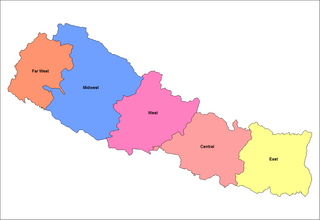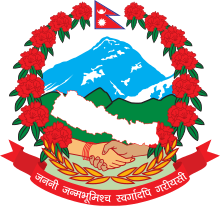
Biratnagar is a metropolitan city in Nepal, which serves as the capital of Province No. 1. With a population of 242,548 as per the 2011 census, it is the largest city in the province and also the headquarters of Morang district. As per the preliminary report of 2021 Nepal census, Biratnagar has an estimated city population of 244,750. It is one of the cities of the Greater Birat Development Area which incorporates the cities of Biratnagar-Itahari-Gothgau-Biratchowk-Dharan primarily located on the Koshi Highway in Eastern Nepal, with an estimated total urban agglomerated population of 804,300 people living in 159,332 households. Biratnagar is located 399 km (248 mi) east of the capital, Kathmandu, and 6 km (3.7 mi) north of the bordering town of Jogbani in the Indian state of Bihar.

Tribhuvan University is a public university located in Kirtipur, Kathmandu. Established in 1959, TU is the oldest university in Nepal. In terms of enrollment, it is the 12th largest university in the world. The college offers 1000 undergraduate and 500 postgraduate programs across a wide range of disciplines. Additionally, the institution has 30 constituent campuses and over 600 affiliated colleges across the country. Because it is government-funded, the tuition fees are less expensive than that of private (affiliated) college campuses.

The Terai or Tarai is a lowland region in northern India and southern Nepal that lies south of the outer foothills of the Himalayas, the Sivalik Hills, and north of the Indo-Gangetic Plain. This lowland belt is characterised by tall grasslands, scrub savannah, sal forests and clay rich swamps. In North India, the Terai spreads from the Yamuna River eastward across Haryana, Uttarakhand, Uttar Pradesh, Bihar and West Bengal. The Terai is part of the Terai-Duar savanna and grasslands ecoregion. The corresponding lowland region in West Bengal, Bangladesh, Bhutan and Assam in the Brahmaputra River basin is called 'Dooars'. In Nepal, the term is applied to the part of the country situated north of the Indo-Gangetic Plain. Nepal's Terai stretches over 33,998.8 km2 (13,127.0 sq mi), about 23.1% of Nepal's land area, and lies at an elevation of between 67 and 300 m. The region comprises more than 50 wetlands. North of the Terai rises the Bhabar, a narrow but continuous belt of forest about 8–12 km (5.0–7.5 mi) wide.

Morang District is located in Province No. 1 in eastern Nepal. It is an Outer Terai district. It borders with Bihar, India to the South, Jhapa to the East, Dhankuta and Panchthar to the North, and Sunsari to the west. Morang has one metropolitan city (Biratnagar), eight municipalities and eight rural municipalities. The total area of Morang is 1,855 km2 (716 sq mi). The lowest elevation point is 60 meters and the highest is 2410 meters above sea level. The headquarters of Morang is connected by Koshi National Highway to the east–west Mahendra National Highway at Itahari, Sunsari, and Morang is also connected to the Hill parts of the eastern region of Nepal. Morang is the core industrial sector for the eastern region of Nepal.

Birgunj is a metropolitan city in Parsa District in Madhesh Province of southern Nepal. It lies 135 km (84 mi) south of the capital Kathmandu, attached in the north to Raxaul in the border of the Indian state of Bihar. As an entry point to Nepal from Patna, Birgunj is known as the "Gateway of Nepal". It is also called "Commercial capital of Nepal". The town has significant economic importance for Nepal as most of the trade with India is via Birgunj and the Indian town of Raxaul. Tribhuvan Highway links Birgunj to Nepal's capital, Kathmandu.

The All Nepal Football Association (ANFA) is the governing body of football in Nepal. It is responsible for the national team as well as club competitions. The organisation was founded in 1951 as the All Nepal Football Association and became affiliated with FIFA in 1972. The current President of ANFA is Pankaj Bikram Nembang. Its current headquarters is located in the ANFA House in ANFA Complex, Satdobato.

Hetauda is a sub-metropolitan city in the Makwanpur District of Bagmati Province in central Nepal. It is the administrative headquarters of the Makwanpur District and the capital of Bagmati Province as declared by majority Provincial Assembly Members on 12 January 2020. It is one of the largest cities of Nepal. At the time of the 2015 Nepal census, it had a population of 153,875 people. The city had a population of 195,951 in 2021.

Prior to the promulgation of a new constitution in 2015 after an earthquake, Nepal was divided into five development regions, 14 administrative zones and 75 districts. The 14 administrative zones were grouped into five development regions. Each district is headed by a Chief District Officer (CDO) responsible for maintaining law and order and coordinating the work of field agencies of the various government ministries.

Birtamod is a municipality in Jhapa District of Nepal. It is the commercial, educational and transport hub of Jhapa District. Sarnamati Bazar, Dhulabari Bazar, Dhaijan Bazar, Charali Bazar, Shivasatakshi Bazar, Kamatoli Bazar, Chakchaki Bazar and Surunga Bazar are some of the nearest local towns/settlements connected to Birtamod. it is one of the fastest growing city in Nepal. Birtamod is the largest city of Jhapa as well as in Mechi zone.
Krishnanagar is a municipality in Kapilvastu district of Lumbini Zone in the western terai part of Nepal. The municipality was established on 18 May 2014 by merging the existing Krishnanagar, Sirsihawa, Shivanagar village development committees (VDCs). on Nepal's southern border with India across from Barhani Bazar. Movement of Indian and Nepalese nationals across the border is unrestricted, however there is a customs checkpoint for goods. Goods bound for Dang and Arcghakhanchi cross here. Krishnanagar is connected by F-12 Chandrauta-Krishnanagar to the east-west Mahendra Highway and Postal Highway.

The Nepalese Ministry of Minister of Industry, Commerce and Supplies is a governmental body of Nepal to monitor and manage industries of the country.
Gaindakot is a municipality in Nawalpur District in the Lumbini Zone of southern Nepal. It became a municipality in May 2014 by merging the existing Mukundapur, Amarapuri, and Gaindakot VDCs. It was again expanded by merging Ratanpur VDC. It is situated on the shore of Narayani River in the lap of Maula Kalika temple. So this place has a great possibility of tourism development. At the time of the 2011 Nepal census, it had a population of 58,841 and 13,623 individual households according to 2011 Nepal census. Contributed in the article by Prashant Subedi

Madhyabindu is a municipality of Nawalpur District in Lumbini Zone of Southern Nepal. The municipality was established on 19 September 2015 by merging the existing Tamasariya, Naya Belahani and Kolhuwa Village development committees (Nepal)|Village development committee]]s (VDCs). The center of the municipality is established in the former Tamasariya VDC of Chormara Bazaar. After merging the three VDCs population it had a total population of 28,224 according to 2011 Nepal census. After the government decision the number of Sub Metropolitan cities and municipalities has reached 12 and 217 respectively in Nepal.

Smart or STPL is a private mobile network service provider of Nepal. The company was established on 1 July 2008. It has been extending its network with an aim of having coverage of the entire of Nepal. On 28 October 2017 the company launched its 4G services in Kathmandu, Lalitpur, Bhaktapur and Pokhara, and is planning to launch 4G in other parts of Nepal soon. The company is famous for providing fastest mobile internet services in the country.

The Department of Customs of Nepal is an administration of Government of Nepal under the Ministry of Finance which collects customs duty, Value Added Tax, excise and other taxes at the border points and international airport. The Department of Customs is responsible in contributing to the economic and social prosperity by providing professional and quality assured customs services in Nepal. Its mission is promoting and facilitating legitimate trade, protection of society and collecting the revenue.

Former administrative units of Nepal are administrative divisions during Kingdom of Nepal. In 2008 Nepal was proclaimed a federal republic and old administrative units restricted after adoption of new constitution on 20 September 2015.
Parwanipur is the smallest rural municipality in Bara District in Madhesh province of Nepal. It was formed in 2016 occupying current 5 sections (wards) from previous 5 former VDCs. It occupies an area of 15.48 km2 with a total population of 22,787. It lies approximately 12 km north to the Raxaul custom of Indian state of Bihar. Parwanipur is known as an industrial corridor of Nepal. Tribhuvan Highway links Parwanipur city with Birgunj metropolitan and Nepal's capital, Kathmandu. Parwanipur is known as industrial manufacturing hub which encompass variety of company such as pharmaceuticals, textile, plastic, steel, vegetable ghee and food industry. This municipality is also known for its major political scrum which has originated many prominent leaders and political activist.














